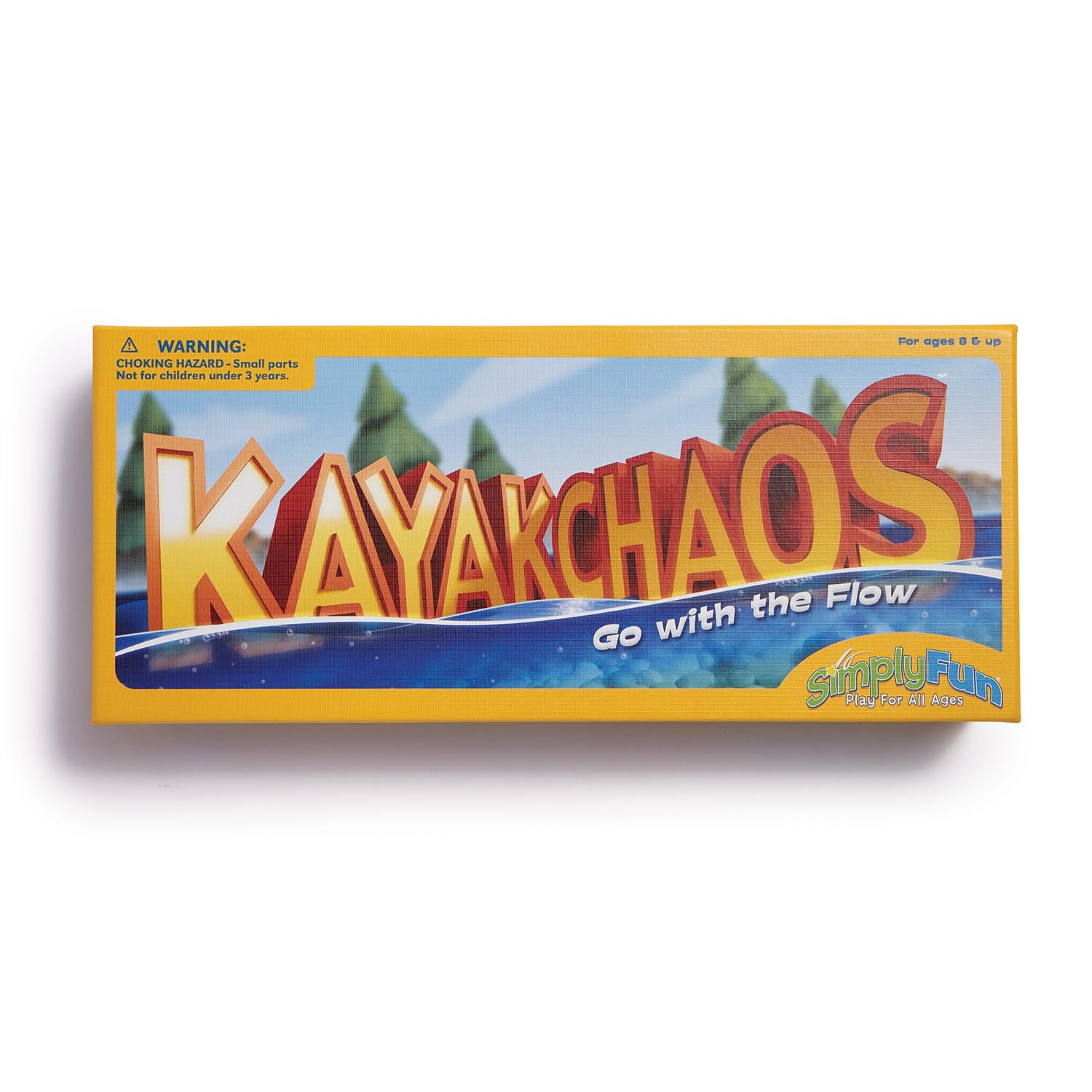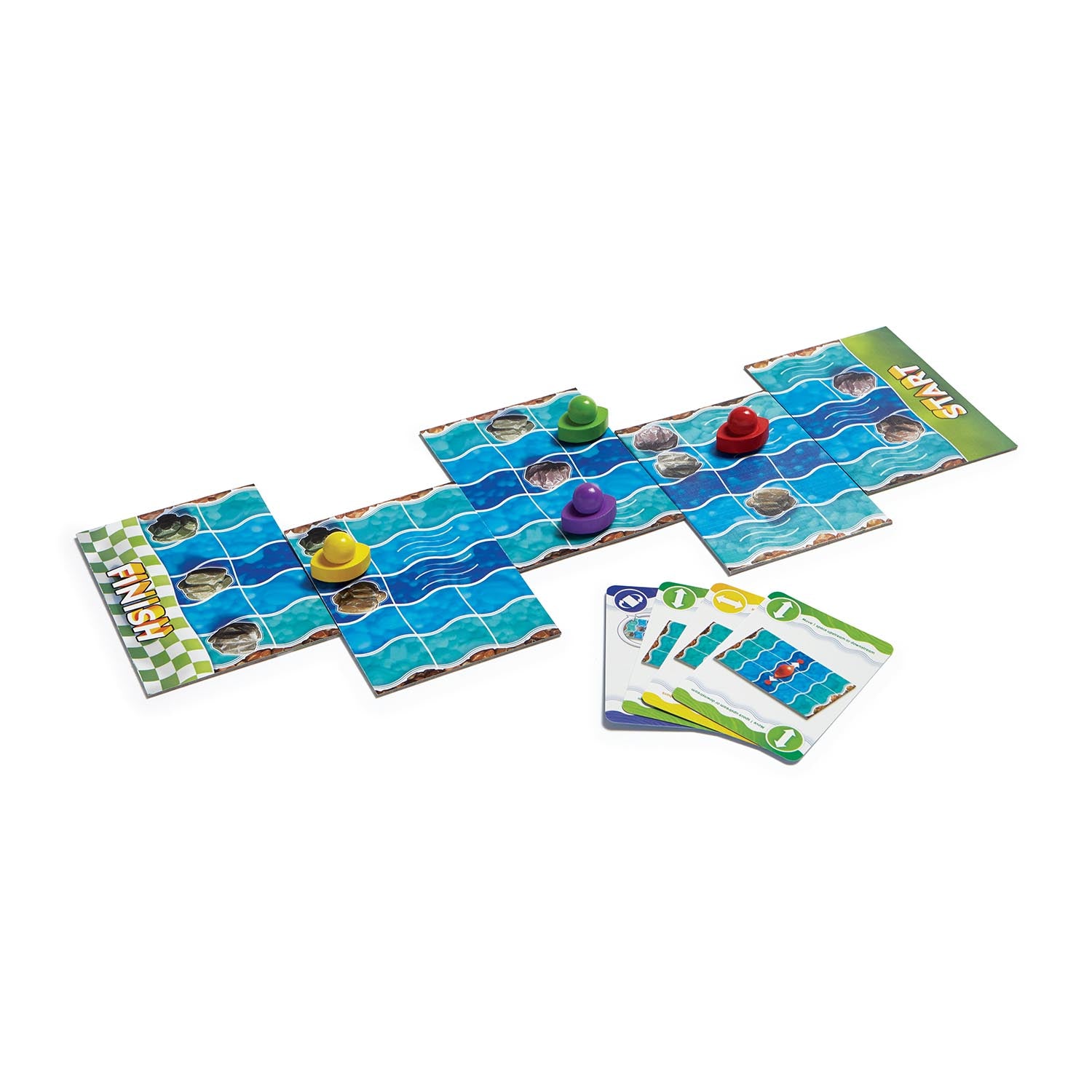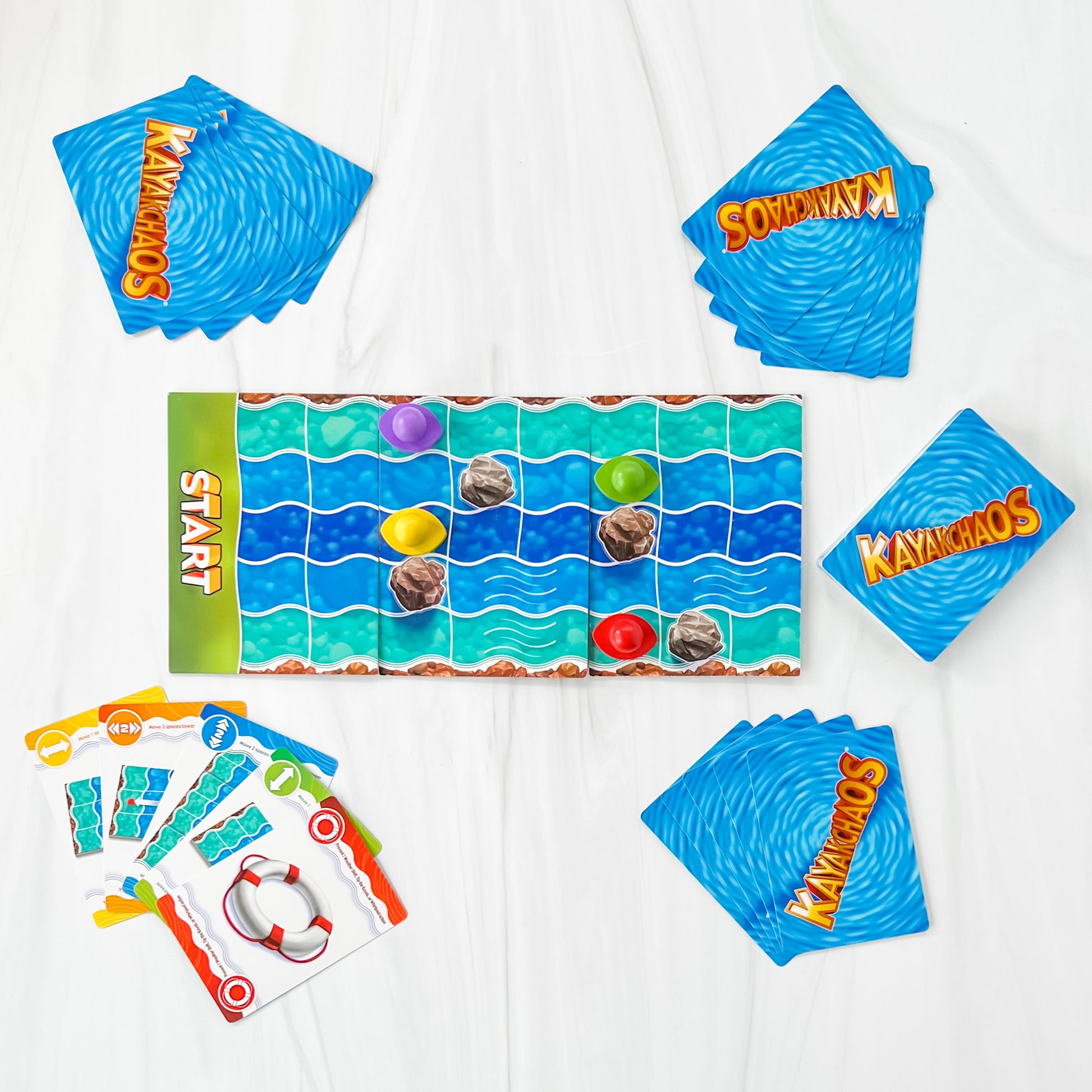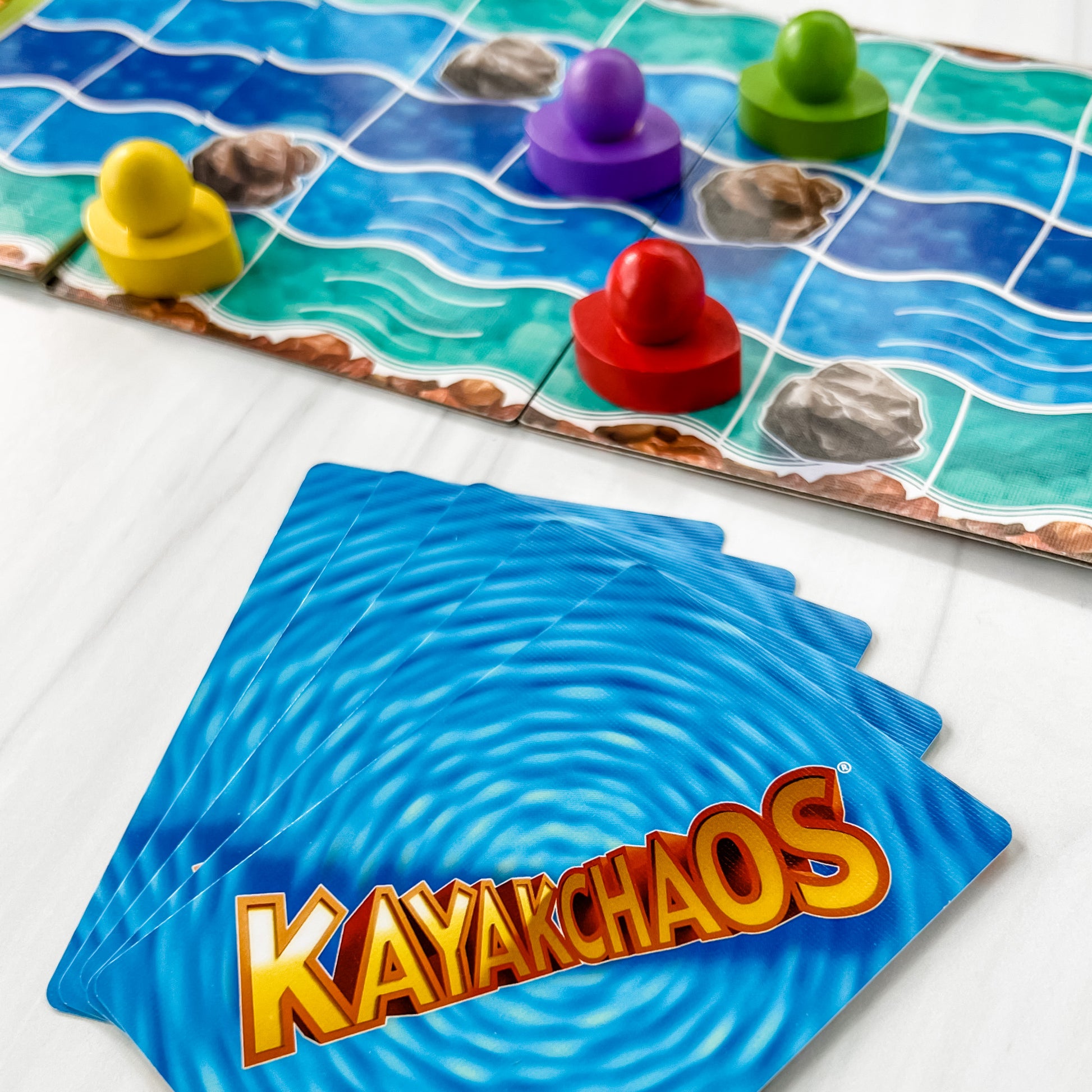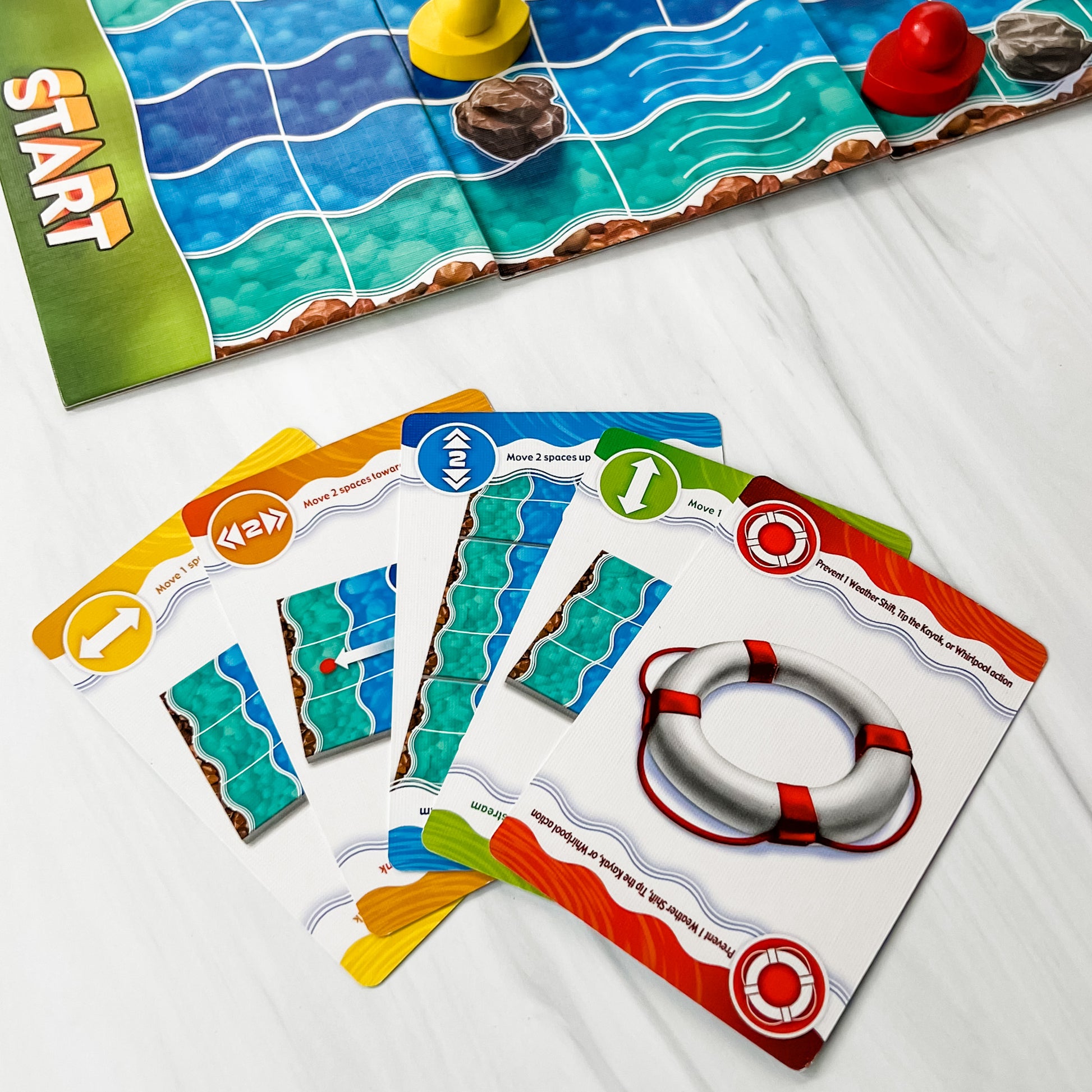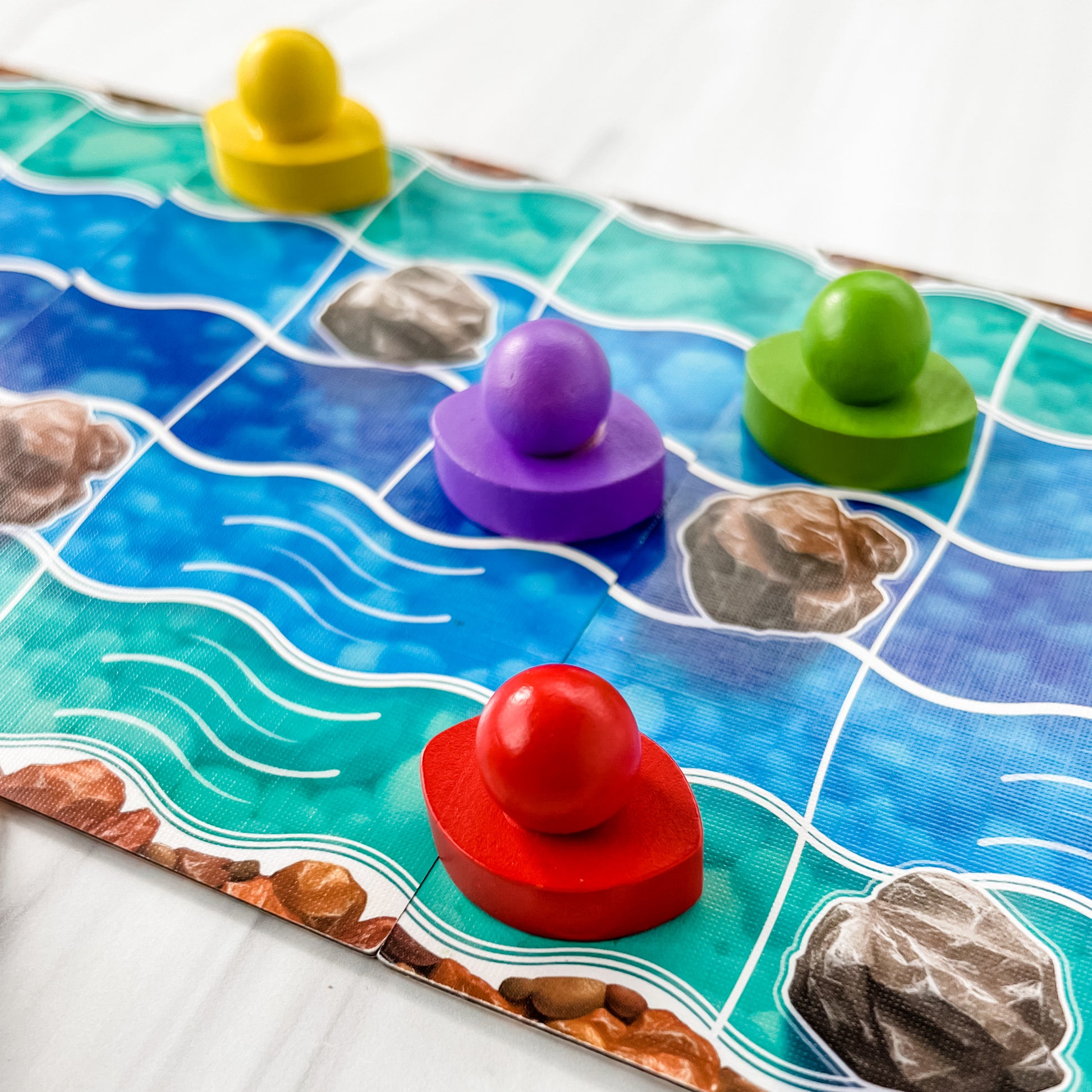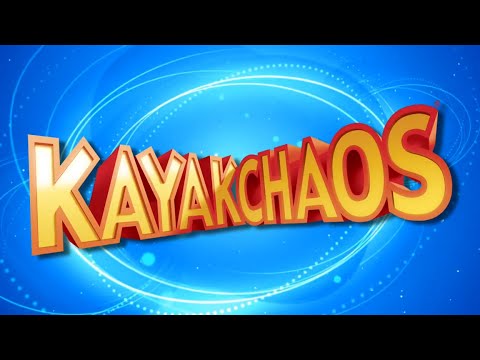Kayak Chaos
Kayak Chaos
2-4 players • 30 min • 8 & up
Focus: Planning
Couldn't load pickup availability
Plan and predict how the water flows to avoid the chaos of swift currents and rocks in your kayak. As you go, you'll also build the river and see who can safely navigate all the challenges.
Skills: Planning, Predicting
Game Includes
Game Includes
- 54 Action Cards
- 8 River Tiles
- 4 Kayak Pawns
- Rules Booklet
Share
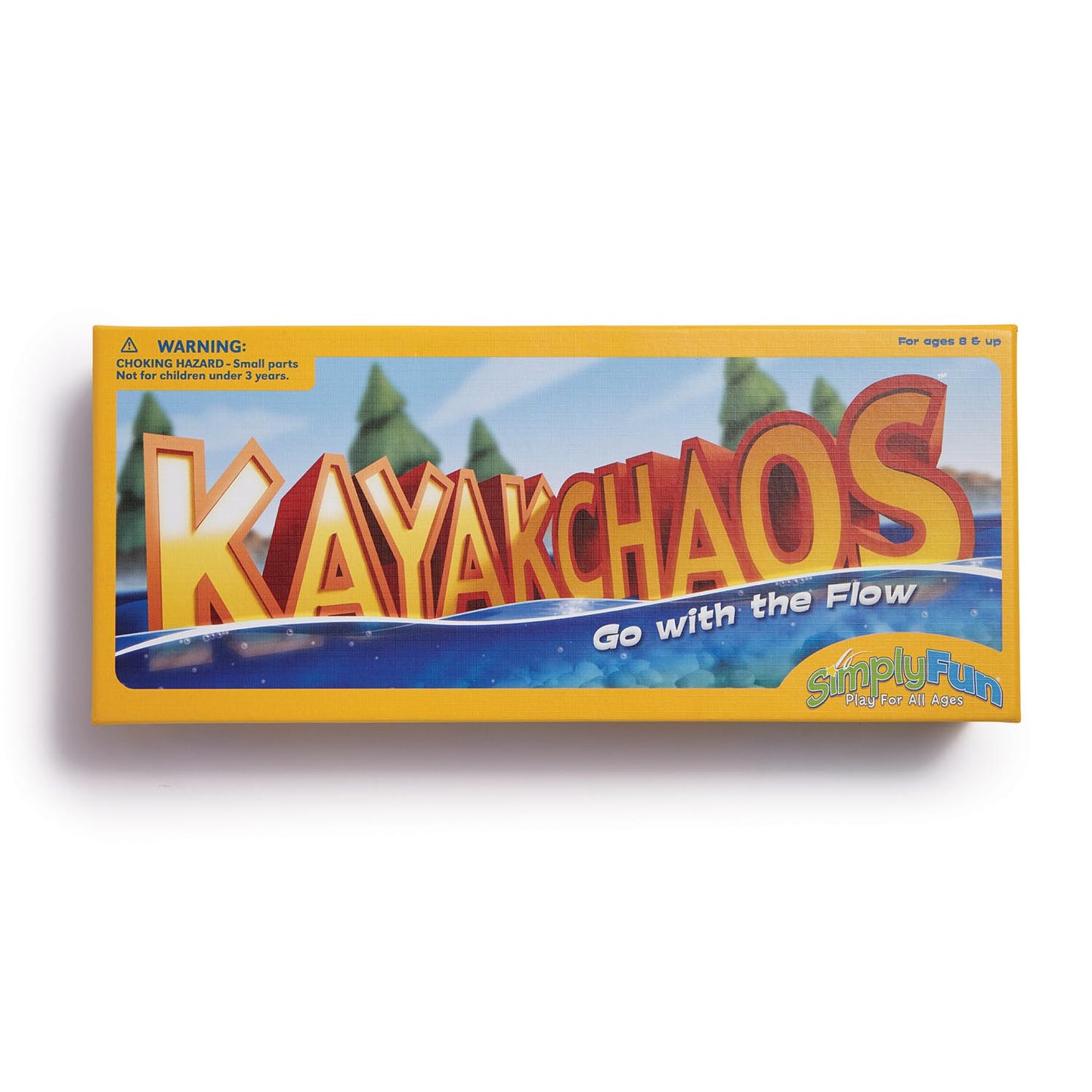
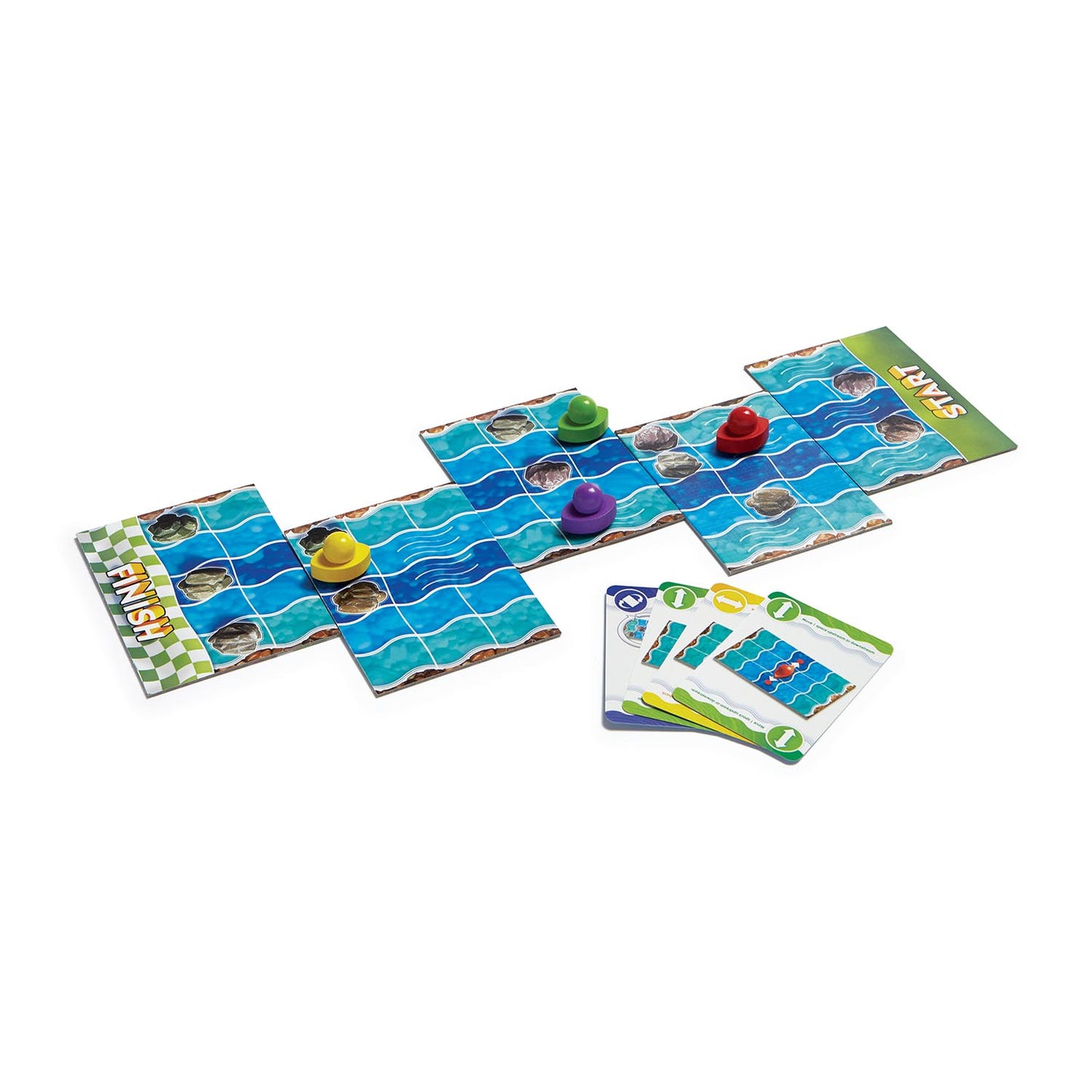
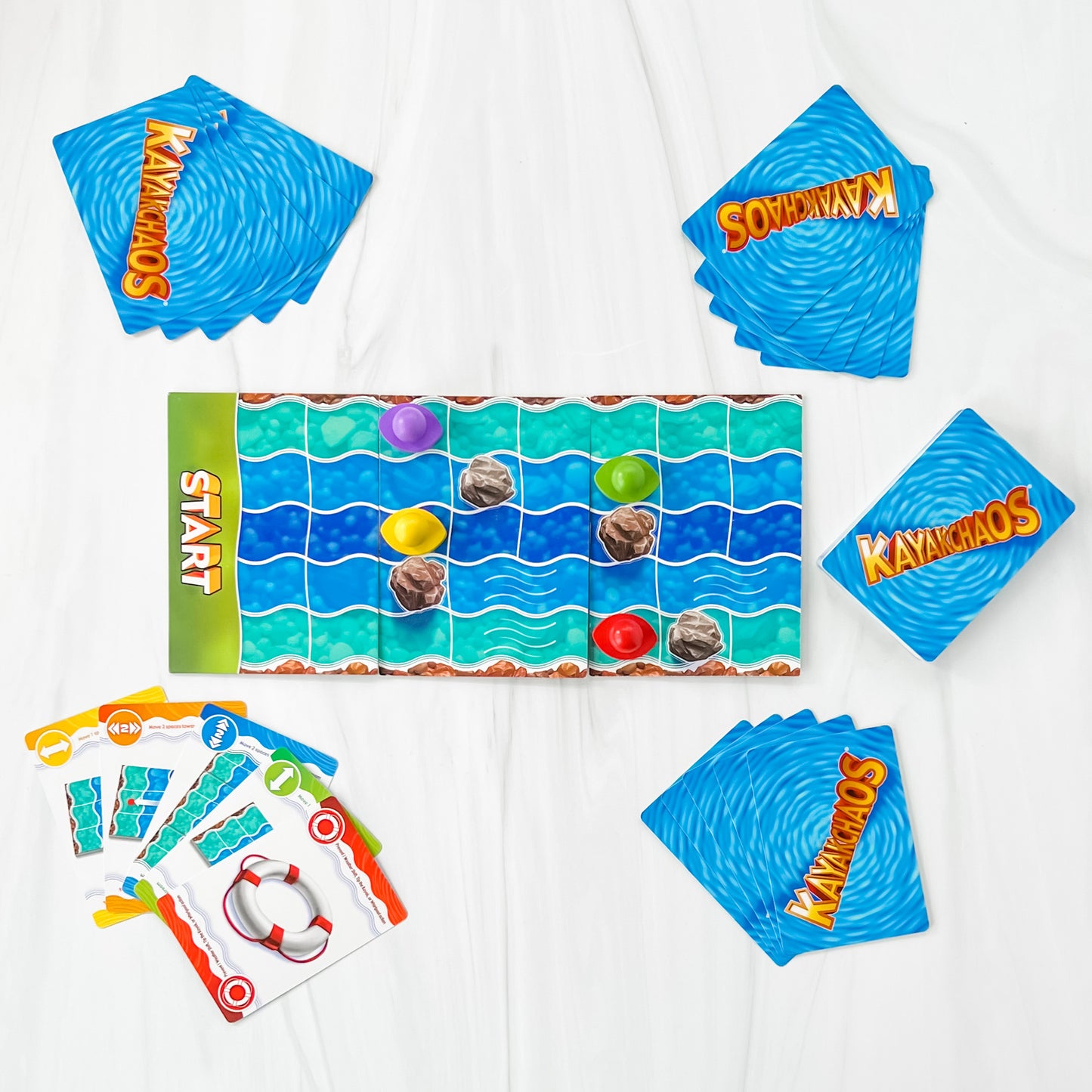
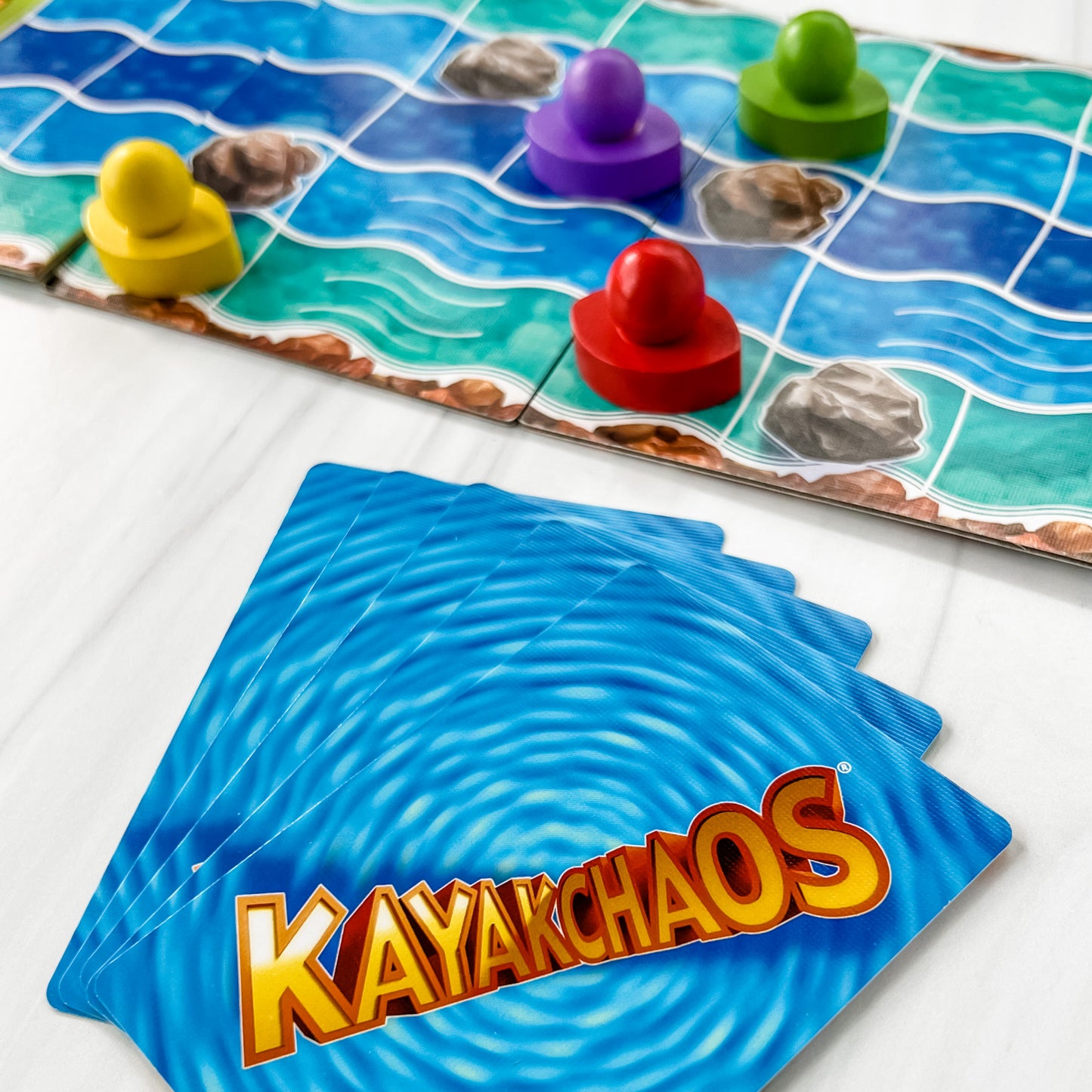
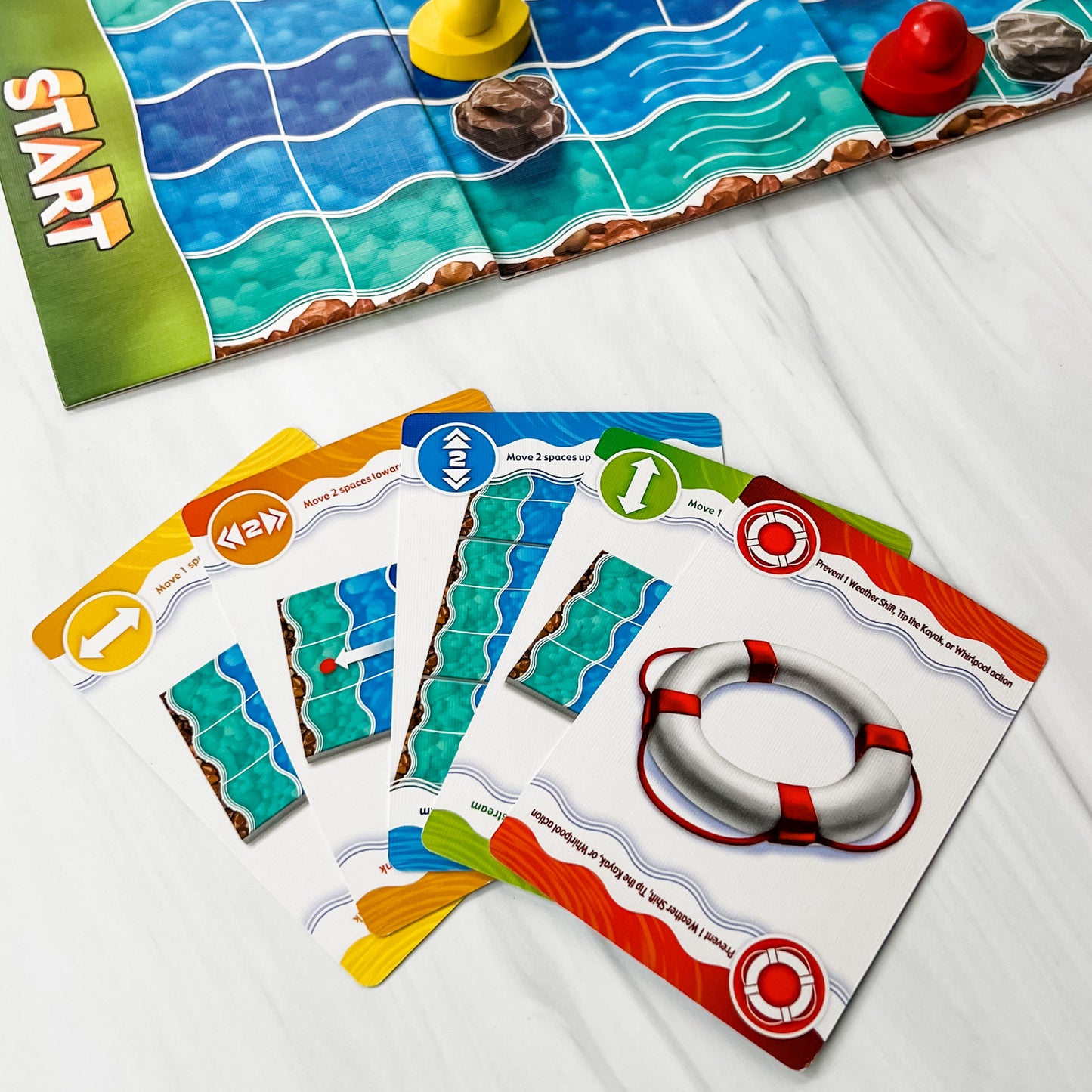
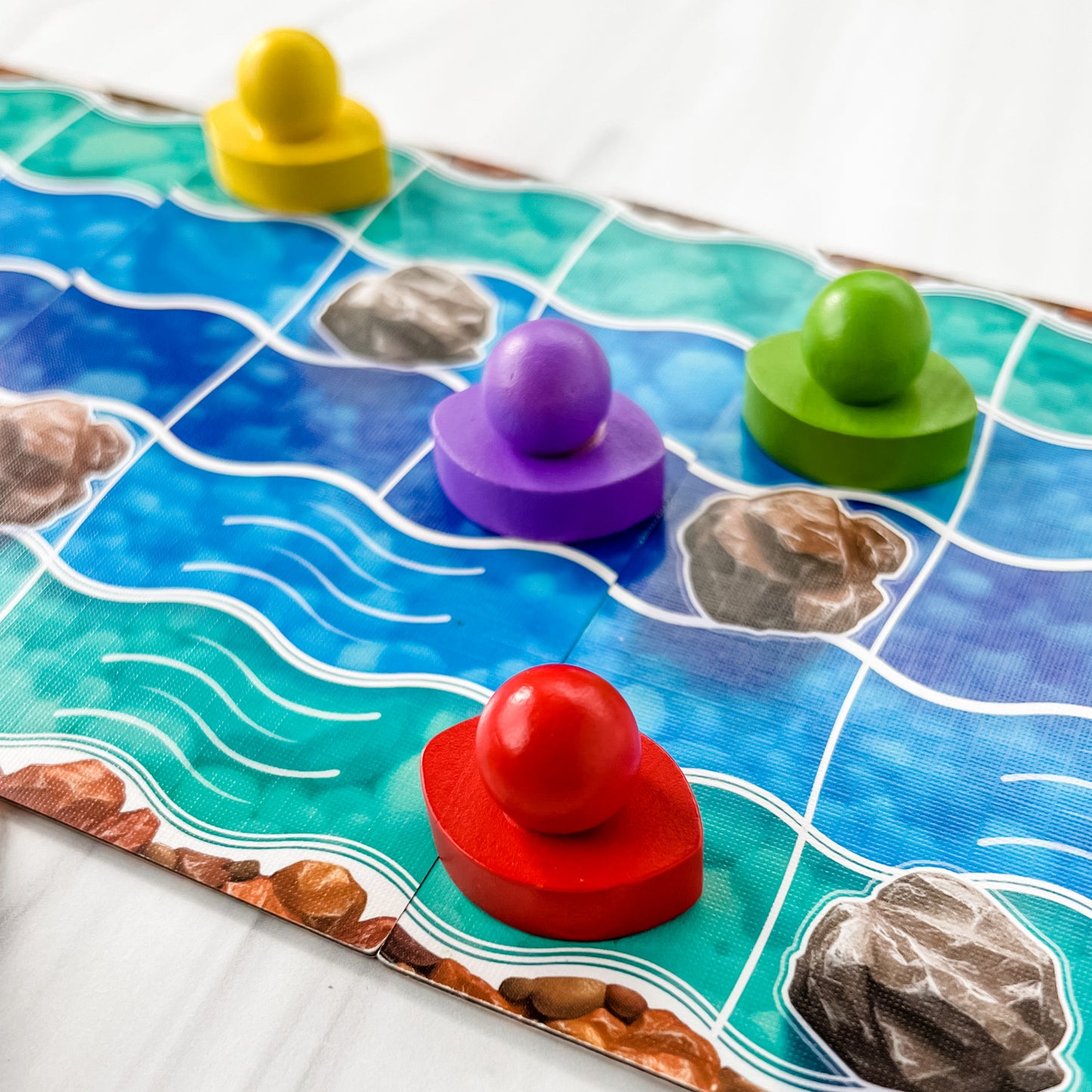
Collapsible content
How to Play
Educational Standards
Core Standard*: Math
Math
- Geometry
- Reason with shapes and their attributes. Grade Levels 2nd, 3rd
- Mathematical Practice
- Make sense of problems and persevere in solving them. Grade Levels 3rd, 4th
- Look for and make use of structure. Grade Levels 3rd, 4th
Skills
Explore
What Does Child Do To Use Skill In The Game?
When a player gets to place a River Tile, they will examine it to see the different paths and blocks.
How Parents Can Assist Learning
Parents can encourage children to look at both sides of the River Tile and rotate each 180 degrees prior to deciding how to place the tile.
Learning Implications and Educator Support
Children are using spatial reasoning and developing strategy skills in Kayak Chaos.Educators can encourage children to look at both sides of the River Tile and rotate each 180 degrees prior to deciding how to place the tile.
Determine
What Does Child Do To Use Skill In The Game?
Players need to determine what each card in their hand means and what options they have on their turn. Sometimes players get to place a River Tile, therefore, will need to figure out the different consequences of placing either side down in different orientations.
How Parents Can Assist Learning
When first learning to play, remind children to look at both sides of the River Tile and rotate each 180 degrees prior to deciding how to place the tile.
Learning Implications and Educator Support
Children are using spatial reasoning and strategy skills in Kayak Chaos.Educators can encourage children to look at both sides of the River Tile and rotate each 180 degrees prior to deciding how to place the tile.
Compare
What Does Child Do To Use Skill In The Game?
Players compare the different pathways, including the blocks and rapids, and the location of all the kayaks in order to help determine which cards to play, how to place a River Tile and what may be the fastest path to the finish line.
How Parents Can Assist Learning
When a child has the opportunity to place a River Tile or play the Weather Shift, Tip the Kayak or Whirlpool cards, the child needs to think about and compare the different pathways and effects of playing the Tiles or cards. Discuss the possible consequences of playing a certain tile. Verbalizing is a good technique for improving analysis, and can help the parent understand how the child is thinking about his or her options.
Learning Implications and Educator Support
The most advanced form of comparison in this game is the comparing of mental models. When a child has the opportunity to place a River Tile or play the Weather Shift, Tip the Kayak or Whirlpool cards, the child needs to think about and compare the different pathways and effects of playing the Tiles or cards. This type of mental mapping and comparison is great for developing spatial awareness and transformational thinking. Transformational thinking underlies skills like puzzle solving and art creation.
Remember
What Does Child Do To Use Skill In The Game?
Players who are placing a River Tile need to remember the different pathways that each orientation of the Tile creates. This is a short term memory skill.
How Parents Can Assist Learning
If children have difficulty remembering, try playing with only one side of the River Tiles. Also, allow children to try out different orientations of the River Tile adjacent to the river, prior to making final decision on how to play the tile.
Learning Implications and Educator Support
If children have difficulty remembering, try playing with only one side of the River Tiles. Also, allow children to try out different orientations of the River Tile adjacent to the river, prior to making final decision on how to play the tile.
Plan
What Does Child Do To Use Skill In The Game?
The core skill used and learned playing Kayak Chaos is planning. Players need to plan which path to take, how to block others, and how to adapt when they are block or their position changes in some way.
How Parents Can Assist Learning
When the game starts, parents can ask children to think about different approaches they might take such as get down the river fastest or try to block opponents as much a possible. Then, as they draw and use cards, the child can try to execute the strategy. If the strategy is not working, suggest alternatives to help them adapt and make new plans. Also, encourage children to order the cards in their hand in a way that they intend to play them on the next two turns.
Learning Implications and Educator Support
Planning is an important skill for developing strategic thinking and reaching a goal. In Kayak Chaos , the planning includes both spatial and cognitive assessment, evaluation and organization.
When the game starts, adults can ask children to think about different approaches they might take such as get down the river fastest or try to block opponents as much a possible. Then, as they draw and use cards, the child can try to execute the strategy. If the strategy is not working, suggest alternatives to help them adapt and make new plans. Also, encourage children to order the cards in their hand in a way that they intend to play them on the next two turns.
Experiment
What Does Child Do To Use Skill In The Game?
Players who are playing a River Tile will flip and rotate the Tile to change perspective, thereby, make it easier to decide what is optimal way to play the tile.
How Parents Can Assist Learning
When first learning to play, remind children to look at both sides of the River Tile and rotate each 180 degrees prior to deciding how to place the tile. Parents can also encourage experimentation by suggesting that a child play a card, even if they are unsure whether it is the "right" move. Trying different cards in different situations will help child learn what moves are most and least effective in various circumstances. This will help them be better players in later games. And, trying new things when you are unsure, yet in a safe environment, helps build confidence and a positive approach to failure.
Learning Implications and Educator Support
When first learning to play, remind children to look at both sides of the River Tile and rotate each 180 degrees prior to deciding how to place the tile. Parents can also encourage experimentation by suggesting that a child play a card, even if they are unsure whether it is the "right" move. Trying different cards in different situations will help child learn what moves are most and least effective in various circumstances. This will help them be better players in later games. And, trying new things when you are unsure, yet in a safe environment, helps build confidence and a positive approach to failure.
Solve
What Does Child Do To Use Skill In The Game?
The river and the kayaks change throughout the game. This means that players will need to shift perspective, adopt new strategies and change plans to challenges and take advantage of new opportunities. Players who are lucky enough to get a Life Ring will use it when they think it is most helpful to propelling them to victory.
How Parents Can Assist Learning
Encourage children to remain flexible in their approach to the game. For example, s/he may be moving downstream fast, but then an opponent plays a Whirlpool and now they are behind everyone. Rather than trying to catch up right away, s/he may need to change to a blocking strategy, trying to slow down the opponents.
Learning Implications and Educator Support
Playing Kayak Chaos helps children learn perspective changing, spatial reasoning, and prioritization, all important elements in strategic thinking.
Encourage children to remain flexible in their approach to the game. For example, s/he may be moving downstream fast, but then an opponent plays a Whirlpool and now they are behind everyone. Rather than trying to catch up right away, s/he may need to change to a blocking strategy, trying to slow down the opponents.
Review
What Does Child Do To Use Skill In The Game?
Players may review if encouraged. See How Parents Can Assist Learning.
How Parents Can Assist Learning
Although not required, having children describe why they made a specific move is a good way to determine their thinking. In some cases parent may discover there was no strategy, the child was just acting impulsively. In this case, the move can be analyzed and discussed.
Learning Implications and Educator Support
Educators need to understand children's thinking and approach to problem solving. Kayak Chaos give children many opportunity to change strategy. Having children describe why they made a specific move is a good way to determine their thinking. In some cases educator may discover there was no strategy, the child was just acting impulsively. In this case, the move can be analyzed and discussed.
Imagine
What Does Child Do To Use Skill In The Game?
Children may use imagination if encouraged. See Implications for Learning and Adult Support.
How Parents Can Assist Learning
To stimulate their imaginations, ask children to imagine what's on the riverbanks or what will the kayakers eat at the end of the race.
Learning Implications and Educator Support
To stimulate their imaginations, ask children to imagine what's on the riverbanks or what will the kayakers eat at the end of the race.
Create
What Does Child Do To Use Skill In The Game?
Children may be creative if encouraged. See Implications for Learning and Adult Support.
How Parents Can Assist Learning
Try creating an pretend adventure for the Kayak Chaos game. For example, you could say, "We are all racing down the Grand Canyon. Every time its your turn, tell us something that you "see."
Learning Implications and Educator Support
Try creating an pretend adventure for the Kayak Chaos game. For example, you could say, "We are all racing down the Grand Canyon. Every time its your turn, tell us something that you "see."
*Data compiled from CCSSI ELA Standards, WA Science Standards, and Washington Social Studies Standards
Special Needs
Cognitive
Suggestions for How to Modify Play Experience
To make the game easier to understand for children with cognitive delays eliminate the Tip the Kayak, Weather Shift, and Whirlpool cards. These cards require children to be able to envision what the river will look like after the transformation. This may be very difficult for children with delays or some types of learning disabilities. Play with the other cards only, until the child understands the game. Then add in the Weather Shift cards. These are the easiest perspective shifts to visualize. If children understand these add the Whirlpool cards. Final, if the child comprehend these, add the Tip the Kayak cards. The Life Saver card may also be removed for the most simple version and added back in when the perspective shift cards are added in.
Communication
Suggestions for How to Modify Play Experience
Pretend you are really on a Kayak trip. Each player must make a statement about the trip before playing a card. For example, "I am going down the Colorado River." The child then plays a card. " I see a deer." The child plays another card. "The deer is looking at me." The child plays the third card. Each player can either add to the first player's story or make up another one. This variation requires children to communicate ideas related to the river to others and, potentially, sequence ideas. If children cannot think of something to say, other players can ask them questions. For example, "What do you see on the bank of the river?" This helps children structure a thought and also learn to respond to questions. As an additional assist, an adult may add the beginning of a sentence, such as "I'm paddling..."
Sensorimotor
Suggestions for How to Modify Play Experience
Play the game. Then set up a river course in the living room. Make race lanes. Use pillows for rocks. Use only the Paddle and Swerve cards, plus the Lifesaver cards. An adult holds the cards and hands them out at each player's turn. Players take the number of steps in the directions indicated on the card. Players can only jump a pillow if they have a Life Ring card; otherwise they must go around the rock.
After playing the game several times ask the child to draw their own Kayak race course, complete with rocks and maybe other obstacles. The child then plays the game with the game cards and the child's race course. Make additions as needed. For example, if the child forgets to make spaces, these can be added together. This is a good supplemental activity for children with fine motor concerns.
Social Emotional/Behavioral
Suggestions for How to Modify Play Experience
Children with poor social skills may need prompting to wait for their turn. A simple suggestion, such as "my turn," "John's turn," "One more, then it is your turn," can help structure turns. Children with autism or other social or cognitive issues may not understand another person's perspective. They think it should always be their turn. After several prompts using the same words, ask the child, "Whose turn is it now?" They may pick up on the sequence, even though they still would prefer it to be their turn!
Vision
Suggestions for How to Modify Play Experience
For children with low vision use a black marker to outline the spaces on the river lanes to provide more contrast. You may also want to start with fewer river tiles to reduce visual complexity. Add additional pieces as the child moves forward.
For children with low vision, set up a river course in the living room. Make race lanes. Use pillows for rocks. Use only the Paddle and Swerve cards. An adult holds the cards and hands them out at each players turn. The adult reads the card and players take the number of steps in the directions indicated on the card. Adults provide directional cues as needed.
Hearing
Suggestions for How to Modify Play Experience
Children with hearing impairments should be able to play the game by just revealing their card and playing the moving the kayak.
*Data compiled from CCSSI ELA Standards, WA Science Standards, and Washington Social Studies Standards
Autism
Autism Strengths & Interests
Short Summary of Strengths & Interests
- Likes to analyze spatial relationships.
- Can predict cause and effect.
- Is good at paying attention to a game board during others' turns.
Is good at matching visual items
This game is not appropriate
Has a good memory for sensory details, including visual, touch, taste and smell
This game is not appropriate
Has a good memory for words, phrases and dialouge
This game is not appropriate
Has a good memory for pictures, numbers and patterns
Is This Game Appropriate? Yes
Description
Players need to be able to interpret the symbols on the play card options and translate these into potential risks or benefits. Therefore, children who are good at memorizing symbols and pictures can use that skill playing Kayak Chaos This game is not appropriate
Likes to put things in order or a sequence
Is This Game Appropriate? Yes
Description
Some children enjoy placing things in a sequence such as lining up dominoes, coins or action figures. These children will likely enjoy the river building aspect of Kayak Chaos as they place new tiles down to create a longer river.
Learns through visualizing or "replaying" actions in their mind
This game is not appropriate
Likes activities with rules, such as math and phonics
This game is not appropriate
Is very concrete and literal
This game is not appropriate
Learns in small "chunks" (for example, phone numbers are 3 chunks of number xxx-xxx-xxxx that are combined together)
This game is not appropriate
Is good at nonverbal reasoning and logic
Is This Game Appropriate? Yes
Description
Some children are good at logic and reasoning, but do not like to discuss or verbalize their thinking. Kayak Chaos is a good match for these children, since players demonstrate their reasoning through action. Namely, they determine where to move their kayak and how to shift the river to their advantage.
Likes spatial problem solving
Is This Game Appropriate? Yes
Description
Children with autism who are good a spatial problem solving can use that skill to do well at Kayak Chaos. This game is involves analyzing the board for best moves, but also envisioning what changing the path of the river could do to individual player's pieces.
Can read well with good vocabulary, though may not fully comprehend content
This game is not appropriate
Likes to use and has good fine motor skill
Is This Game Appropriate? Yes
Description
Kayak Chaos requires good dexterity as players place and manipulates river tiles and their game tokens. Therefore, children who like using their fine motor skills will enjoy that part of playing the game.
Likes established routines or set ways of doing things
This game is not appropriate
Likes manipulating, constructing or building things
This game is not appropriate
Likes to use and has good musical abilities
This game is not appropriate
Likes to use and has good drawing skills
This game is not appropriate
Autism Special Considerations
Appears to ignore other's communication and/or has difficulty giving eye contact to a communication partner
Is This Game Appropriate for Child with Characteristic? Yes
Can Child with Characteristic Play Game w/o Modification? Yes
Strategies for Developing Compensatory Skills:
Sit at an angle to the child, so direct eye contact is not needed.
Look at the game instead of each other.
Use unusual or exaggerated inflection to begin a communication about the game. This attracts the child's attention.
Has difficulty understanding complex verbal directions
Is This Game Appropriate for Child with Characteristic? No
Can Child with Characteristic Play Game w/o Modification? No
Strategies for Developing Compensatory Skills:
Kayak Chaos is not an appropriate game for children who have difficulty understanding complex directions.
Uses vocabulary inaccurately or demonstrates echolalia (repeating another's speech)
Is This Game Appropriate for Child with Characteristic? Yes
Can Child with Characteristic Play Game w/o Modification? Yes
Strategies for Developing Compensatory Skills:
Respond to immediate echolalia (repeating what was just said) by rephrasing the child's response into a correct format, so the child can hear and repeat that phrase. For example, assume you are playing with a child named Andy and you say, "Your turn," and Andy repeats, "Your turn." You can say, "It's Andy's turn. You say, my turn." This allows the child to hear and repeat the correct response. Eventually, the child will pick up the pattern of response.
Delayed echolalia (repetition of previously heard comments) may have a hidden meaning or association. Look for connection in the phrase used to the current situation. For example, the child says, "After these messages we'll be right back!" Think what the repeated phrase is associated with for the child. Try to interpret what is meant and rephrase it for the child. For example, you might respond by saying, "It sounds like you want a break for a few minutes. Is that what you mean? You can tell me, 'I need a break.'"
Gets stuck repeating a verbal topic or physical actions and/or has difficulty attending to others' actions or topic.
Is This Game Appropriate for Child with Characteristic? No
Can Child with Characteristic Play Game w/o Modification? No
Strategies for Developing Compensatory Skills:
Children need to pay attention to other player's intentions and actions, as there are both offensive and defensive components to play. For this reason, Kayak Chaos is not recommended for children with this concern.
Has difficulty producing speech/communication
Is This Game Appropriate for Child with Characteristic? Yes
Can Child with Characteristic Play Game w/o Modification? Yes
Strategies for Developing Compensatory Skills:
Use augmentative communication, such as picture cards. For example, a picture of person pointing to another person means "your turn." Although communication is not required, players will want to explain their moves. For this reason, the game may be difficult for children with special needs to play.
Has difficulty sequencing multi-step actions and/or doing complex abstract tasks
Is This Game Appropriate for Child with Characteristic? No
Can Child with Characteristic Play Game w/o Modification? No
Strategies for Developing Compensatory Skills:
Kayak Chaos has very complex directions and involves abstract tasks. It is not recommended for children with special needs.
Demonstrates difficulty initiating and maintaining social interactions
Is This Game Appropriate for Child with Characteristic? Yes
Can Child with Characteristic Play Game w/o Modification? Yes
Strategies for Developing Compensatory Skills:
Develop a social story to be read at the start of a game. A social story is a short booklet that illustrates how a child can use positive social skills. It includes two to five descriptive statements and a directive statement. For example: "When I watch others, I will know when it is my turn. Others like me when I take turns. I will watch what others do with their pieces and listen to what they say. Others like it when I talk about the game." Add photos or drawings of the child doing the actions described in the story.
Role play social situations and reinforce appropriate words and actions. For example, role play commenting on another player's turn. For instance, "You pushed that kayak down the river."
Use video feedback of positive social behaviors. Video of actual play enables children to see what they or others did. Appropriate actions and interactions can then be discussed.
Acts out or demonstrates avoidance behaviors when frustrated, overwhelmed, or needs more sensory input.
Is This Game Appropriate for Child with Characteristic? Yes
Can Child with Characteristic Play Game w/o Modification? No
Strategies for Developing Compensatory Skills:
Reduce extraneous noise or allow the child to wear head phones or ear plugs if loud sounds cause anxiety.
A weighted vest worn during the game may provide additional pressure input and thus reduce fidgeting due to sensory needs. Pressure can be calming when used for no more than 20 minutes at a time.
Practice a phrase to ask for help and role play situations in the game where it is needed.
Provide techniques for self-calming, such as holding a special toy.
Allow time for movement. For example, a child who needs to move frequently can be given an opportunity to 'celebrate' their turn by running around the table or jumping up and down 10 times.
Has short attention span for non-preferred activities
Is This Game Appropriate for Child with Characteristic? No
Can Child with Characteristic Play Game w/o Modification? No
Strategies for Developing Compensatory Skills:
Not recommended for children with a short attention span. The game requires concentration.
Needs sameness or consistent routines and/or has difficulty with transitions from one activity to another
Is This Game Appropriate for Child with Characteristic? Yes
Can Child with Characteristic Play Game w/o Modification? Yes
Strategies for Developing Compensatory Skills:
Play games at the same time every day, so the child anticipates the game routine.
Change the location of the game, so the child may play in different rooms, at the table, or on the floor. This will build tolerance for variation. Prepare the child ahead time for the introduction of a new game. Talk about aspects that will be motivating for the child, and let them explore the parts of the game before setting out the whole game.
Provide a structure for placement of game pieces that can be the same each time the game is played. For example, have a specific location for where the board goes, the pieces, etc.
Provide choices for how the child can be involved in set up or clean up. For example, you might ask, "Do you want to hand out the kayaks or set up the board?" Involve the child verbally and with actions for the transition to the game table or at the end of game play. For example, you might say, "Let's look at the pictures on the game box and guess what it is about."
Use an object cue. Let the child hold an object from the game or activity you want to introduce prior to the transition. For example, if you were intending to play Kayak Chaos, you would hand the child a kayak from the game and say, "Look here is a kayak. What game does it go with?"
Has difficulty understanding others' feelings, intentions, and the reasons for others' actions.
Is This Game Appropriate for Child with Characteristic? No
Can Child with Characteristic Play Game w/o Modification? No
Strategies for Developing Compensatory Skills:
Kayak Chaos is not recommended for children who have difficulty understanding others intentions and reasoning.
*Data compiled from CCSSI ELA Standards, WA Science Standards, and Washington Social Studies Standards
Extended Play
Extra Ways to Play the Game
Play the game with the same rules, but start with eight cards for each player and put all the other cards face down in a draw pile. In this version, players may not discard any cards, except under one situation. If the cards the player has in his or her hand do not allow any movement forward, the player may discard two cards and draw two additional cards. On each turn, a player must play 2 cards. Play continues until all players have no cards or cannot play any more cards. Any unused cards are put in a pile off to the side. If no one has reached the finish, then deal out six cards to each player and repeat playing 2 cards at a time. If no one has reached the finish after this round, deal four cards and so on to two cards. Stop as soon as someone gets to the finish.
Materials Needed
No additional materials are needed.
Developmental Benefits
This expansion has the benefit of forcing players to make the best choice they can, even if they don't have the cards they want. Players must then analyze their cards very carefully to make a plan. This variation has the additional challenge of reducing the choices with each round of play, as players get closer to the finish line.
Extra Ways to Play the Game
Keep all rules the same except the life preservers can be used for an extra reason. The life preserver can be used to turn the river card totally upside down. The player(s) on the river tile that is turned over fall(s) off and must go to the first available spot on the next card UPSTREAM. This adds an extra element of excitement and risk to the game.
Materials Needed
No additional materials are needed.
Developmental Benefits
This expansion can actually send players back upstream, setting them back in the race. This adds a new defensive strategy to the game. Players must now consider more carefully the value of playing the life preserver card stop a harmful move or saving it for critical situation.
*Data compiled from CCSSI ELA Standards, WA Science Standards, and Washington Social Studies Standards
Collapsible content
How to Play Video & Transcript
Get your paddles ready, because today, we’re going kayaking on the river – a river that YOU build as you go – with Simply Fun’s Kayak Chaos.
Kayak Chaos is played with 2 to 4 players ages 8 and up.
In each Kayak Chaos box you’ll find:
• Fifty four Action Cards
• eight River Tiles
• four Kayak pawns, and
• one rules booklet
In Kayak Chaos be the first to maneuver your kayak up, down and across the river to reach the end – but be careful. Rocks and competing kayakers are bound to stir up some chaos.
To set up the game, remove the river tiles from the box. Choose either side of the start tile and place it in the middle of the table, leaving room for the river to grow. Place the finish tile to the side. Shuffle the remaining tiles and stack them on top the finish tile. Allow each player to select a Kayak pawn and place all the pawns on the starting space.
Next, take the action cards from the box and shuffle them. Deal five cards to each player. Place the remaining cards beside the stack of tiles as a draw pile. Now you’re ready to run the rapids!
At the beginning of the game, the river is short – only the start tile. When a player performs an action that moves his kayak off a tile, a new tile is drawn from the stack and aligned with the previous tile. The player has the option to flip or rotate the tile as he chooses, but it must be aligned. If a player performs an action that pushes an opposing player off a tile, that player selects and aligns the new river tile, opening new possibilities and obstacles.
On each turn, a player may perform up to three actions by either playing a card or discarding a card. These actions direct the player’s boat down the river or around obstacles. Players also have a few special maneuvers that can affect the river – and other players!
Each player may perform any of the actions on his cards, but may not perform more than three per turn. At the end of a turn, the player draws new cards to replace those that were played or discarded.
There are 8 different card types in Kayak Chaos, each of which can be played, to advance a player’s position, or discarded to avoid an unwanted action. Each card constitutes an action and each card also has limitations. Refer to the rules booklet for specific stipulations.
Let’s take a quick look at the various Action Cards:
1. Paddle Cards are green, and allow players to move their pawns one space up- or downstream.
2. Double Paddle Cards are blue and are the same as the green Paddle cards, but allow players to move their kayaks two spaces up or down stream.
3. Swerve Cards are yellow. They allow players to steer one space to the left or right to avoid obstacles.
4. Double Swerve Cards are orange and allow players to swerve two spaces left or right.
5. Turquoise Weather Shift cards shift the river’s course. When playing a weather shift card, a player moves the water tile not the kayak, shifting the river by one space to either side.
6. Indigo – or dark purple – ‘Tip the Kayak’ cards are similar to the Weather Shift cards but instead of shifting the river’s course, it rotates the tile by 180 degrees.
7. Whirlpool cards are violet. By playing this card, a player may exchange two adjacent river tiles, each taking the position of other.
8. Red Life Ring cards are unique. They are played on ANOTHER player’s turn. Using the Life Ring card, a player prevents one Weather Shift, Tip the Kayak or Whirlpool action from taking place. In essence, the Life Ring is a “cancel” card. It still counts as an “action” but not against the active player – rather against his opponent, who must play the next turn with only four cards in hand. At the end of the next turn, the player may replenish his hand with the normal five cards.
One other action can affect the game: Pushing Kayaks. This happens when one Kayak moves onto a space occupied by another kayak. It causes a collision, sending the lead Kayak into the next space. Any number of kayaks can be pushed, as long as they move to legal spaces and are not pushed onto rocks or the riverbank.
The game ends when the first player reaches the finish space and wins the game.
Brave the chills and thrills as you run the rapids toward victory with Kayak Chaos!
Subscribe for More Fun!
Be the first to know about new games, exclusive offers and more.
- YouTube
- TikTok
- X (Twitter)
- Choosing a selection results in a full page refresh.
- Opens in a new window.



